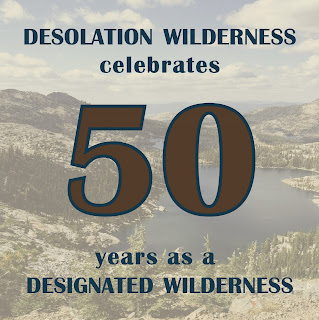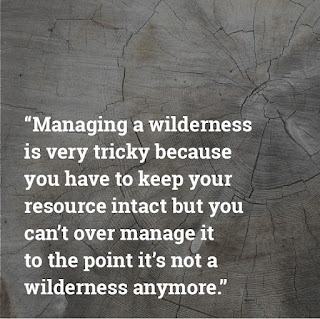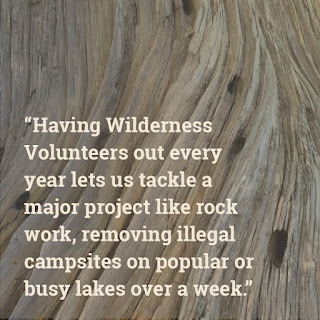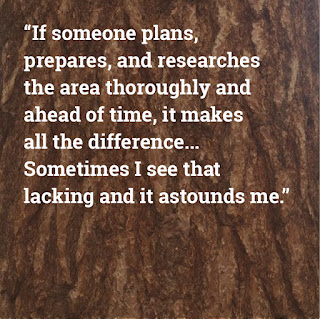2019 is a monumental year for Desolation Wilderness as it celebrates 50 years as designated wilderness. This rugged northern California region was first called the Desolation Valley Primitive Area in 1931, later gaining wilderness status in 1969. Those who have had the fortune to visit know the inexplicable beauty to be found: 63,960 acres that span both sides of the Sierra Nevada, alpine/subalpine landscapes, 130+ brilliant blue alpine lakes, and 27 hard trails. Desolation Wilderness sees the most visitors annually for a wilderness its size and contains segments of the Pacific Crest Trail (PCT), the Tahoe Rim Trail (TRT), as well as the Crystal Range.
For many years, Wilderness Volunteers have fielded week-long projects in coordination with the Eldorado National Forest (EDNF). Together, we’ve tackled bigger projects including trail work, rockwork, water mitigation, illegal campsite removal, and crosscut projects. I reached out to our EDNF liaison, Wilderness Ranger Dustin Bell, to learn more about the state of Desolation Wilderness (DW), what we can do to help preserve it, and what you can do to be a good outdoor recreator.
 Thank you for taking the time for this interview. To provide a context for our readers, please tell us your name, your position, and how long you’ve been working in Desolation Wilderness.
Thank you for taking the time for this interview. To provide a context for our readers, please tell us your name, your position, and how long you’ve been working in Desolation Wilderness.
Absolutely. My name is Dustin Bell and I’m a Wilderness Ranger for the Eldorado National Forest. I’ve been working in Desolation for over 10 years.
What makes Desolation Wilderness unique or special?
Desolation offers accessibility for people to enjoy the wilderness that is unlike a lot of other wilderness areas. You can get into a wilderness area without having to trek out to Montana or Idaho and have a full itinerary. This area is very accessible from all sides of the wilderness with 15 trailheads leading in. It’s co-managed by the Eldorado National Forest and the Lake Tahoe Basin Management Unit.
Desolation gets the wrap of being one of the most heavily used designated wildernesses in the U.S. Is this still true and do you have any numbers or trends you could share?
Yes, definitely. Per acre, we’re the most used wilderness area in the country. There are a lot of numbers thrown out, but we get 150,000-180,000 visitors per year on roughly 64,000 acres. A lot of the use is on the Tahoe side (6 trailheads) and the southern end of the wilderness. As you go farther north, you’re definitely going to find more solitude (9 trailheads).
 2019 is the big 5-0 for Desolation. Are there any celebratory plans happening or in the works?
2019 is the big 5-0 for Desolation. Are there any celebratory plans happening or in the works?
We are having our annual end of the season Desolation Wilderness Volunteers gathering be a combination 50th Birthday party for Desolation. This will be open to more than just volunteers, we will have family, friends, and fellow Forest Service employees such as the visitor services people who issue permits on hand to help celebrate and recognize everyone’s hard work that goes into protecting and managing Desolation Wilderness.
How’s the season going so far?
It’s been a really good season. Obviously, the later snowpack has caused a lot of challenges for visitors and staff. There’s a lot of snow left, but it’s been melting pretty quickly in the past few weeks. Now we’re dealing with high water crossings and wet trails, but it’s also good in that it gives this wilderness area a bit of a break this year.
What are some long term challenges Desolation Wilderness faces?
I would say mitigating impacts and I don’t mean just with resources but more so on the experience. Mitigating impacts without having to limit the number of visitors, even more as it stands now. We’re only getting busier, and day hikers make up the majority of our numbers.
Managing a wilderness is very tricky because you have to keep your resource intact but you can’t over-manage it to the point it’s not a wilderness anymore. We’re walking that fine line between making sure visitors have an enjoyable, safe, pleasant experience while also not guiding them to their exact campsite.
Are there any new obstacles on Desolation’s plate? Perhaps something that wasn’t an issue 5-10 years ago?
It’s not necessarily a modern obstacle, but over the past few years it’s been a trend: we are seeing increased bear activity including their success in getting food. For example, this year we have a bear in the Lake Aloha area that has been able to get down bear hangs. I don’t really know the quality or accuracy of these bear hangs. We have some bears who are particularly habituated in how to get hangs down. Because of this, we are advocating bear canisters even more. We have them to borrow at the ranger’s station for free. We’re communicating our bear issues to visitors any chance we get.
Something else which sticks out and isn’t a pleasant topic would be human waste. Improper disposal of these things including toilet paper. We advocate packing out your waste and TP, and we even distribute little black bags when we issue permits and ask visitors to pack out their toilet paper in the black bag. If people do their part now, hopefully, we won’t get to the point of requiring bear canisters or requiring people to pack out their waste. We need to be more responsible, especially in the heavily used areas.
What’s a positive way technology has impacted Desolation Wilderness?
A pro to technology would be the campsite inventory program that we have, allowing us to monitor all of the campsites in DW. We are transitioning to working on tablets and with GIS (geographic information system). Previously, we were carrying clipboards, tons of paper, binders, you name it. It will greatly improve our data collection abilities and it’s great that we can tie it into GIS.
What are some challenges you see with technology and its use in Desolation?
There are plenty of apps and GPS based options, like AllTrails. Some are for PCT hikers that show them were campsites are. Our staff constantly monitors these references to ensure that they’re giving out proper information and we’ll send out requests for information to be changed, clarified or removed.
Something we see is that people use and heavily rely on these apps/technology/electronics. I see visitors not preparing and researching as well, making all their decisions solely based on their app/electronics. They come in without a map, follow their GPS and then something happens to it. It dies or gets damaged and they don’t possess the skills or tools to work outside of their electronics.
We have also noticed some worrying trends this year with Spot devices, InReaches, and other emergency communication devices. It seems that people are activating them too soon or aren’t aware of the severity involved when activating these devices. We have had some instances where it wasn’t necessary to activate; these individuals could have taken their time, made a plan, rested longer, hiked out slower, etc. This results in a drain on our resources, from unnecessary helicopter flights to someone being located. This also impacts other visitors when you have a helicopter in your wilderness evacuating someone.
As a Wilderness Ranger, could you expand on the value and role volunteers or volunteer groups provide in the stewardship of Desolation?
With so many visitors, there’s a lot of areas our rangers can’t cover and visitors they can’t talk to. We focus our patrols in the heavily used areas and areas we are doing trail work.
Volunteers and volunteer groups, like Wilderness Volunteers, are able to help us take care of projects that we wouldn’t be able to accomplish outside of our normal job. Trail work, trail clearing, campsite restoration, campsite monitoring— volunteers are all crucial in allowing us to complete these larger-scale projects. We work with many volunteer programs, from Desolation Wilderness Volunteers, Back Country Horsemen, SCA, conservation organizations from where we get our interns.
Having Wilderness Volunteers out every year lets us tackle a major project like rock work, removing illegal campsites on popular or busy lakes over a week. The efforts from volunteers also allow us to reach the most visitors and inform about wilderness ethics and safety. Our volunteers are like an extension of the rangers as they are helping us meet our goals.
What would you say to someone who was perhaps unfamiliar with or on the fence about the stewardship of public lands?
We need to have people to manage and protect these areas so that they don’t get loved to death. Stewardship allows you to build a personal connection to a place. You get to see your work, it builds that bond with that area that trail. As rangers, we see the areas in which we work as our second homes. We want to protect it, keep it safe and clean as you would with your own home. It’s not just for us, it’s for you and for future generations as well.
When people volunteer and work in the wilderness they really feel fulfilled and there’s pride. They’re happy to see someone use that staircase they built and it’ll be there for their lifetime. Additionally, informing and encouraging people to be on the side of wilderness. So many people don’t know what wilderness is or understand the idea of it. That’s another reason we encourage people to volunteer; some people don’t know these things exist.
 How do you develop the list of projects to be done in Desolation?
How do you develop the list of projects to be done in Desolation?
We have a DW Management Plan which outlines standards and guidelines in managing wilderness. From there, it’s a combination of field reports from rangers and volunteers. Our trails person and I will also hike out, trying to take care of the more impacted areas and busier trails, focusing on restoration and clearing trails. By working here over several seasons, you pick up on areas which need attention and we try to check those off year by year.
The campsite monitoring program & GIS help as well; they allow us to input all this information into a database. I can perform very refined searches which can help inform which projects we’ll do.
There’s a work plan which is reviewed with my supervisor in winter and spring. We share our ideas, where we want to focus our efforts for that year, in addition to coordinating with the Lake Tahoe Basin Management Unit. They are in charge of ⅓ of Desolation and they’re a partner in all of this.
What are the top 3 most common violations you encounter with recreators inside the wilderness boundary?
It’s changed a bit over the years but recently it would be people not camping in their first night’s zone. For those unfamiliar, we have a zone quota system which dictates you stay in your selected zone for the first night of your trip. You can move elsewhere after that. It’s meant to minimize the impact on the land and the concentration of people throughout the wilderness. I’ve seen a lot of people with permits who camp somewhat close and some who are way off from their zone. We try to stress the importance of abiding by your zone because when you don’t your presence negatively impacts the land and those who are properly camped in their zone.
Second would campfires, although thankfully we aren’t encountering them as much this year. The majority of visitors have their permits, which they’ve obtained online at recreation.gov. Frequently, people aren’t thoroughly reading their permits and acknowledging their restrictions beforehand. Have you read and understood your permit? Did you sign your permit? The common violations we encounter are clearly defined in your permit.
The third and frequent violation is camping too close to water. This is a big problem for us. DW requires you camp 100 ft. from water; LNT asks 200 ft. from water. This is important to bring up because our rangers spend a lot of time moving people back away from the water. Sometimes we literally have to move everyone’s camp back. Everyone wants to camp right by the water, and that creates impacted illegal sites.
Desolation offers a wide variety of activities to engage in. When you’re not working, what’s your favorite thing to do out here?
I like fishing and go quite a bit. I like reading, enjoying the peace and quiet. Taking in the sounds of the wind, birds. I like photography, it’s hard to not take pictures when you’re in such a beautiful place. Spending time with my family out there. Backpacking trips with my friends as well. It’s nice to share my world with them and open their eyes to what the wilderness is; a lot of them don’t go backpacking. Maybe I’ll climb a peak every once in a while.
It’s the first tenet of Leave No Trace: plan ahead and prepare. If someone plans, prepares, and researches the area thoroughly and ahead of time, it makes all the difference. It goes beyond getting your permit. Knowing the regulations and current conditions. You’re heading out into the middle of nowhere for several days, you should really be prepared. Sometimes I see that lacking and it astounds me.
Number two: not camping too close to the water or in a sensitive area. It’s pretty awkward for us to tell people to move their campsite. It would honestly make our lives easier: we wouldn’t have to move everyone’s campsites and would remove unpleasant contacts. Some people get upset; I’ve been told I’ve ruined someone’s trip because I had them move their campsite back 50 more feet.
Lastly, be a good example. Everyone’s an “experienced hiker” these days and should be setting a good example for other visitors by being a wilderness steward. We need more stewards to not only spread the word about wilderness but to also actually practice good techniques out there. Sometimes I don’t see this happen with people that clearly have hiking experience.
What’s the coolest thing you’ve seen during your time in Desolation?
Hmmm… that depends. The Perseid meteor shower is always amazing. The height of it lasts a couple of nights… we sleep outside of our tents. It’s a really memorable, cool experience just being able to see countless shooting stars.
 Is there an animal you’re dying to see in Desolation that you have yet to? (photo courtesy of CA Dept. of Fish & Wildlife)
Is there an animal you’re dying to see in Desolation that you have yet to? (photo courtesy of CA Dept. of Fish & Wildlife)
I haven’t seen a bear or mountain lion, but I can’t say that I’m dying to see one. I would love to see a Wolverine, but that’s not going to happen. Maybe there was one reported as far south as Truckee…It’s my favorite animal and it’s not a practical answer for Desolation. I’d be interested in seeing a mountain lion from across the canyon. That’s something that I think would be cool. I don’t want to encounter one, but to see one across a lake or at a far distance would be awesome.
What’s a future goal for Desolation?
A future goal we have is to update the management plan in Desolation. We have some issues that need to be addressed and any changes would have to be done so through this update. If we have to institute bear canisters or even designated campsites, it would be a long process involving a lot of approval.
What excites or inspires you about working in Desolation Wilderness?
Our volunteer program excites me because in 2018 DW Volunteers completed the most hours ever at ~4250. Our program is growing and we add a few more volunteers each year. I’m excited about what they accomplish and know we’ll get even more done. They’re at trailheads talking to hikers, educating visitors, conducting community outreach presentations. I’m really big on reaching visitors before they get to the trails. Once they’re in the wilderness, there’s little opportunity to change.
Ok, final question. Part of my job is understanding how volunteers feel about their projects: they want to know the work they’re doing is needed and meaningful. Overall, how does working with volunteers make you feel?
After I spend time working alongside volunteers, I feel a connection with them. I really appreciate that they’re out there putting forth their time and energy in helping us maintain our wilderness area. It’s more than a working relationship. There’s a personal connection, a friendship, and I consider them a part of our wilderness family. Over the years I’ve made some really good friends. Something about wilderness brings out a personal connection between people. If you spend the time or overnight with someone, inevitably you have a deep conversation.
On behalf of Wilderness Volunteers, I just want to say thank you and that we greatly value our partnership with the Eldorado National Forest. We’re excited about our upcoming September project and the future ones as well.
If you would like to learn more or join our awesome upcoming project in Desolation Wilderness, visit the project page.










